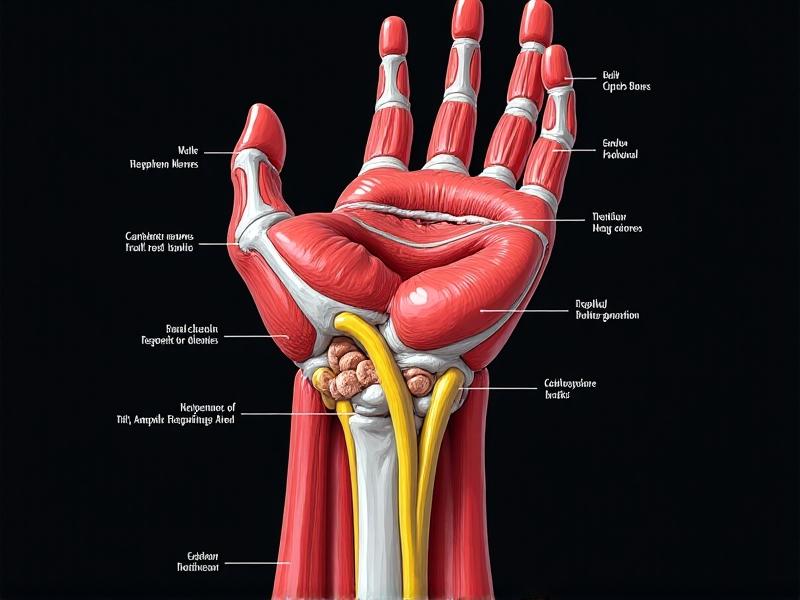```html
The Hidden Link Between Keyboard Use and Wrist Pain
Imagine typing for hours, only to feel a dull ache creeping up your wrists. For millions, this isn’t hypothetical—it’s a daily reality. The way we position our hands on keyboards plays a critical role in musculoskeletal health, yet it’s often overlooked. Wrist angles, in particular, determine whether typing becomes a sustainable activity or a slow-motion injury. When wrists are bent excessively upward, downward, or sideways, tendons and nerves endure unnecessary friction. Over time, this can lead to conditions like carpal tunnel syndrome or tendinitis. Understanding the science behind neutral wrist alignment isn’t just about comfort—it’s about preserving your ability to work, create, and connect.

Anatomy of the Wrist: Why Angles Matter
The wrist is a complex intersection of eight carpal bones, tendons, and the median nerve, all navigating a narrow passage called the carpal tunnel. When you type with wrists bent at 20 degrees or more, this tunnel’s internal pressure increases by up to 300%, according to OSHA studies. Flexion (bending downward) forces tendons to rub against ligamentous walls, while extension (bending upward) compresses the nerve bundle. Neutral posture—where the hand aligns with the forearm—keeps these structures in their natural, low-friction positions. This isn’t mere theory: MRI scans show significantly reduced inflammation markers in typists who maintain 10-15 degrees of wrist extension compared to those with acute angles.

The Goldilocks Zone: Finding Your Neutral Wrist Angle
Neutral isn’t a single position but a range—typically between 10 degrees of extension and 5 degrees of flexion. To find yours, sit upright with shoulders relaxed. Let your arms hang naturally, then notice your wrist orientation: that’s your biological neutral. Most ergonomic keyboards aim to replicate this by offering negative tilt (front higher than back) or tenting (angled upward from center). A 2023 University of Michigan study found that users typing at 13 degrees extension experienced 40% less muscle activation in forearm extensors compared to flat positioning. Pro tip: Place your keyboard so your elbows stay at 90-110 degrees—this automatically promotes healthier wrist angles.

Ergonomic Setups: Beyond the Keyboard Tray
While keyboard trays help, true ergonomics involves systemic alignment. Your chair height should allow feet to rest flat, with armrests supporting elbows at keyboard level. Monitors at eye height prevent neck strain that trickles down to wrists. Split keyboards like the Kinesis Advantage or Microsoft Sculpt encourage a handshake-like position (10-30 degrees of ulnar deviation), reducing forearm rotation. For laptop users, a separate keyboard and riser are non-negotiable—built-in keyboards force harmful wrist extension. A Johns Hopkins meta-analysis revealed that workers using fully optimized stations reported 62% fewer pain episodes than those with partial adjustments.

Dynamic Typing: Movement as Prevention
Static postures are the enemy. Even perfect wrist angles become hazardous when held for hours. Set a timer to micro-pause every 20 minutes: perform wrist circles, finger stretches, or shoulder rolls. The Alexander Technique’s "monkey position"—slightly hinging forward from hips while keeping spine neutral—reduces load on arms during typing sessions. Hydration matters too: well-lubricated tendons glide smoothly through sheaths. A 2022 BMJ study highlighted that typists who combined ergonomic equipment with hourly mobility breaks had 73% lower rates of surgery-worthy injuries over a decade.
Myth-Busting: What You’re Getting Wrong About Wrist Rests
That plush gel wrist rest? It’s likely hurting you. These pads are designed for occasional palm support during pauses—not active typing. Resting your wrists while typing immobilizes forearms, forcing finger muscles to overwork. Instead, float your hands slightly above the keyboard, using arm and shoulder muscles for broader movement. For those needing support, opt for a slim, firm rest placed 2-3 inches behind the keyboard, only touching during breaks. Logitech’s Ergo Lab found that users who transitioned to floating techniques reduced wrist extension by 11 degrees within two weeks.
Future-Proofing: Building Sustainable Typing Habits
Start with awareness: Periodically audit your posture using phone photos or mirror checks. Apps like Posture Reminder use AI to nudge you when slouching. Strengthen antagonist muscles—reverse wrist curls with light weights counteract typing’s flexion dominance. If pain persists, consider alternative input methods like voice typing or stenography keyboards. Remember, adaptation takes 4-6 weeks; track progress in a journal. As Stanford’s Human Performance Alliance notes, the most successful injury-prevention strategies blend ergonomics, movement diversity, and mindful habit formation.




